Breaking Ground in Staunton
In 1848, a group of Lost Creek Baptist Church members began worshipping in a log schoolhouse on Peterson Pike (now Peterson Road) in Staunton Township of Miami County. In the summer time, the meetings were often held outdoors in a nearby grove of trees. These members thought that a new church should be formed that would be closer to the families living along Peterson Pike. So in December of 1850, the group met in conference with the leadership of Lost Creek Baptist Church. At this meeting, Elder Nehemiah Martin was chosen as moderator and Jacob A. Riddle was chosen as clerk. The group asked the clerk to write to nearby churches, asking for a combined council to consult and advise whether the group should organize an independent church or become a branch of the Lost Creek Baptist Church. In the end, the council consisted of two members from the First Baptist Church of Troy, five members from Piqua Baptist Church, two members from Honey Creek Christian Church, three members from First Baptist Church of New Carlisle, six members from Spring Creek Baptist Church, three members from Lost Creek Baptist Church, and four members from Staunton Baptist Church. The council recommended that the group adopt the Declaration of Faith as published by the First Baptist Church of Troy in 1840. After further discussion, it was thought advisable to organize an independent church. On January 9, 1851, a council convened at the home of S. Youart in Staunton Township. With the approval of the advisory council, the thirty charter members decided to form a Regular Baptist church named Union Church.
At the first church meeting on January 11, 1851, the church called Elder Nehemiah Martin to be the church’s first pastor. Church minutes indicate that the church had multiple elders but sustained one of them part-time as the pastor. On February 8, 1851, it was resolved to undertake the building of a clay brick meeting house. It would be thirty-eight feet by fifty feet, and the clay would be taken from the fields behind where the church currently stands. The land for new building was donated by Jacob A. Riddle with a provision that the land would return to his descendants if the church ever ceased to exist. The total cost of the church building was $857.53. This was raised by pledges from $1.00 to $60.00, and some pledges were filled by credit from working, giving materials, and other forms of labor. The first deacons were elected on July 12, and the church joined three associations on September 6: the Mad River Regular Baptist Association, the Dayton Baptist Association, and the Upper Miami Baptist Association.
At the first church meeting on January 11, 1851, the church called Elder Nehemiah Martin to be the church’s first pastor. Church minutes indicate that the church had multiple elders but sustained one of them part-time as the pastor. On February 8, 1851, it was resolved to undertake the building of a clay brick meeting house. It would be thirty-eight feet by fifty feet, and the clay would be taken from the fields behind where the church currently stands. The land for new building was donated by Jacob A. Riddle with a provision that the land would return to his descendants if the church ever ceased to exist. The total cost of the church building was $857.53. This was raised by pledges from $1.00 to $60.00, and some pledges were filled by credit from working, giving materials, and other forms of labor. The first deacons were elected on July 12, and the church joined three associations on September 6: the Mad River Regular Baptist Association, the Dayton Baptist Association, and the Upper Miami Baptist Association.
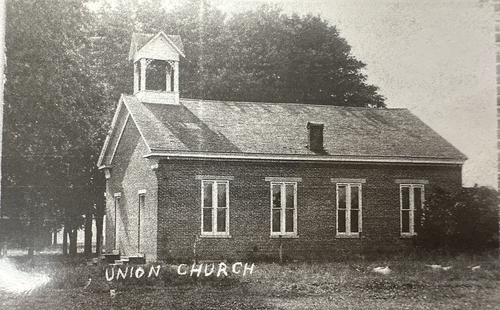
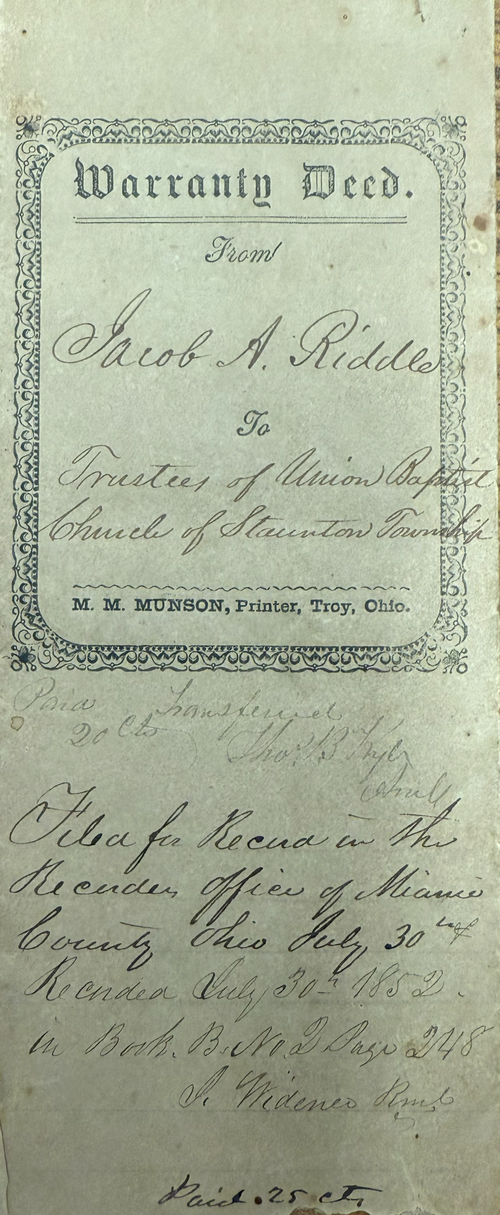
(Above) A photo of the original church building. Date when photograph was taken is unknown.
(Left) The original 1852 warranty deed signed by Jacob A. Riddle that gifted Union Church its plot of land.
(Left) The original 1852 warranty deed signed by Jacob A. Riddle that gifted Union Church its plot of land.
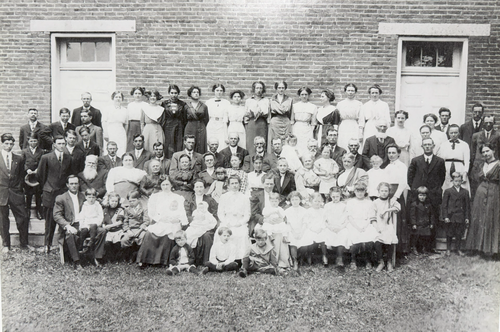
(Above) This photo of Union's congregation is undated, but it is likely from the early 1900s.
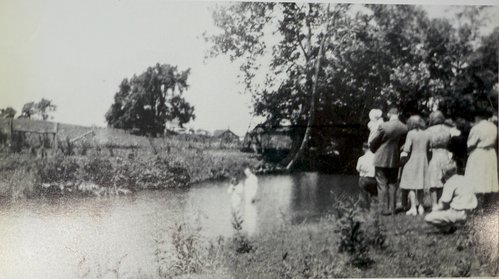
(Above) For the first 125 years of the church's history, baptisms were conducted in Spring Creek just west of the church property. This picture is from the early 1940s.
Building the Foundation
The early years of Union Regular Baptist Church were challenging. As a rural church, the congregation was not able to financially support a pastor preaching every Sunday. Meetings were held once a month, during which a sermon was preached and attendees were invited to become new members by membership transfer or experience (namely, they were not a member of another church, but they had been baptized by immersion and accepted the church’s Declaration of Faith and covenant). From 1850-1945, the church had 27 pastors. Some pastors preached once or twice a month and worked non-ministry jobs to maintain their income, while others pastored Union Baptist and another church simultaneously. The constant arrival and departure of pastors prevented the church from firmly establishing itself and achieving healthy growth.
An excellent example of these challenges was the church's attempt to build a parsonage. In June 1872, the church received an $802.00 pledge for building a parsonage, and the trustees instructed the church to proceed with the stipulation that the cost not exceed $1,500.00. In November of 1872, construction continued to build necessary out buildings at the parsonage. In June of 1876, members decided that if the church couldn't raise money to pay construction debts, then the trustees were to sell the parsonage. In May of 1880, the Trustees reported that the parsonage was sold for $1,050.00 to the Fox family.
Despite these setbacks, Union was able to continue updating the main church building to accommodate the needs of the congregation. Under the leadership of Rev. Samuel Furrow (1916-1921), cement walkways were placed at the double front entrance in June 1916. In November 1919, a new furnace was installed underneath the church and a basement was excavated. Under the leadership of Rev. Clarence Motter (1923-1928), the church hosted its first Homecoming dinner in 1925 and it first started using electricity for church lighting in July 1927. Under the leadership of Rev. Lester Schlechty (1931-1933), Union Baptist became the first church in Troy to install a radio set for sermon purposes.
An excellent example of these challenges was the church's attempt to build a parsonage. In June 1872, the church received an $802.00 pledge for building a parsonage, and the trustees instructed the church to proceed with the stipulation that the cost not exceed $1,500.00. In November of 1872, construction continued to build necessary out buildings at the parsonage. In June of 1876, members decided that if the church couldn't raise money to pay construction debts, then the trustees were to sell the parsonage. In May of 1880, the Trustees reported that the parsonage was sold for $1,050.00 to the Fox family.
Despite these setbacks, Union was able to continue updating the main church building to accommodate the needs of the congregation. Under the leadership of Rev. Samuel Furrow (1916-1921), cement walkways were placed at the double front entrance in June 1916. In November 1919, a new furnace was installed underneath the church and a basement was excavated. Under the leadership of Rev. Clarence Motter (1923-1928), the church hosted its first Homecoming dinner in 1925 and it first started using electricity for church lighting in July 1927. Under the leadership of Rev. Lester Schlechty (1931-1933), Union Baptist became the first church in Troy to install a radio set for sermon purposes.
Post-War Expansion
From 1945-2000, Union Baptist Church experienced a tremendous period of growth and expansion as a congregation. Rev. Harry Manning (1945-1957) provided strong leadership and stability, and been the end of his time at Union he had the longest pastorate to that point in the church's history. Sunday School and Sunday worship attendance were consistently high, and members were enthusiastic about the number of young families joining the church. During Manning's tenure, the church made several upgrades to the main building: a new roof in 1951, a new well in 1952, a new oil furnace and storm windows in 1953, and insulation for the church ceiling in 1955. Manning retired from Union after having served 35 years in pastoral ministry at four different churches.
Rev. Oran Thomas (1957-1964) continued Rev. Manning's work by leading the first major addition to church's building. With the attendance and members increasing, there was a need for additional space. Orville Weatherhead drew up the blueprints, Merlin Elifritz provided a loan to the church, and a building contract was given to Jack Burnside to construct the addition to the back of the church. This addition was completed in 1958 and included three classrooms, a hall, a kitchen, and two restrooms replaced the old furnace room. In 1960, the church completely redecorated and refurnished the sanctuary. The front wall was paneled to cover the old clay brick, the choir loft was changed, the floor was sanded and decorated with new rugs, new drapes were made by the Missionary Society, and new wooden pews and a pulpit were purchased. The same year, there was need for assistance to college students of the church, so a scholarship program was approved by the church. This program has assisted our students for many years, and many students have gone into full-time Christian ministry with our support. On May 7, 1961, the new baptismal pool inside the sanctuary was dedicated during the evening service and used for the first time.
In 1962, as the church continued to grow, additional space was added to the front of the church. Orville Weatherhead again drew up blueprints, a signature loan was obtained from the bank, and members who owned property guaranteed the loan. Ferguson Construction Company from Sidney constructed the addition. It changed the original double entrance to a central entrance, added on room for a nursery and a pastor’s study, and transformed the basement into a finished fellowship hall. It was originally built with a flat roof, but this was updated to an A-frame roof in 1979 that matched the rest of the sanctuary.
In June 1964, with the calling of Rev. Daniel MacDonald (1964-1968) there was a need for a parsonage. The church voted to purchase a home on Alexander Drive in Piqua. The church also installed a complete public address system in the nursery, basement, and sanctuary. Following Rev. MacDonald's resignation, Rev. Robert Maugans (1969-1974) and Rev. Robert Ernst (1974-1984) faithfully led the church to increase its focus on missions giving and community outreach. The church reported record missions giving in the late 1970s that went beyond the budgeted amount each year. In 1982, Bonita Fox in her will gave the farmhouse just to the east of the church back into the church’s possession. This was the original parsonage sold back in 1880. Union's trustees worked on fixing the house and completed the work on May 11, 1984. The church used the house as a rental property for several years.
When Rev. Ernst retired from Union to enter itinerant ministry, Rev. Joe Hyde (1985-1999) finished out the 20th century with the longest pastorate in Union's history. He continued his predecessors' legacy of ministering to families, supporting missionaries around the world, and doing outreach to the surrounding community. At the end of his time with Union, Hyde accepted the call to pastor Highlawn Baptist Church in St. Albans, West Virginia and his last Sunday with the church was on October 24, 1999.
Rev. Oran Thomas (1957-1964) continued Rev. Manning's work by leading the first major addition to church's building. With the attendance and members increasing, there was a need for additional space. Orville Weatherhead drew up the blueprints, Merlin Elifritz provided a loan to the church, and a building contract was given to Jack Burnside to construct the addition to the back of the church. This addition was completed in 1958 and included three classrooms, a hall, a kitchen, and two restrooms replaced the old furnace room. In 1960, the church completely redecorated and refurnished the sanctuary. The front wall was paneled to cover the old clay brick, the choir loft was changed, the floor was sanded and decorated with new rugs, new drapes were made by the Missionary Society, and new wooden pews and a pulpit were purchased. The same year, there was need for assistance to college students of the church, so a scholarship program was approved by the church. This program has assisted our students for many years, and many students have gone into full-time Christian ministry with our support. On May 7, 1961, the new baptismal pool inside the sanctuary was dedicated during the evening service and used for the first time.
In 1962, as the church continued to grow, additional space was added to the front of the church. Orville Weatherhead again drew up blueprints, a signature loan was obtained from the bank, and members who owned property guaranteed the loan. Ferguson Construction Company from Sidney constructed the addition. It changed the original double entrance to a central entrance, added on room for a nursery and a pastor’s study, and transformed the basement into a finished fellowship hall. It was originally built with a flat roof, but this was updated to an A-frame roof in 1979 that matched the rest of the sanctuary.
In June 1964, with the calling of Rev. Daniel MacDonald (1964-1968) there was a need for a parsonage. The church voted to purchase a home on Alexander Drive in Piqua. The church also installed a complete public address system in the nursery, basement, and sanctuary. Following Rev. MacDonald's resignation, Rev. Robert Maugans (1969-1974) and Rev. Robert Ernst (1974-1984) faithfully led the church to increase its focus on missions giving and community outreach. The church reported record missions giving in the late 1970s that went beyond the budgeted amount each year. In 1982, Bonita Fox in her will gave the farmhouse just to the east of the church back into the church’s possession. This was the original parsonage sold back in 1880. Union's trustees worked on fixing the house and completed the work on May 11, 1984. The church used the house as a rental property for several years.
When Rev. Ernst retired from Union to enter itinerant ministry, Rev. Joe Hyde (1985-1999) finished out the 20th century with the longest pastorate in Union's history. He continued his predecessors' legacy of ministering to families, supporting missionaries around the world, and doing outreach to the surrounding community. At the end of his time with Union, Hyde accepted the call to pastor Highlawn Baptist Church in St. Albans, West Virginia and his last Sunday with the church was on October 24, 1999.
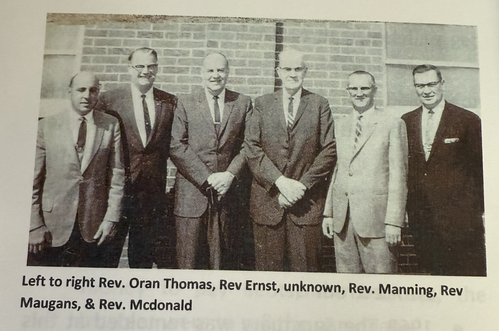
(Above) This photo from one of Union's Homecoming dinners combines all of Union's pastors from 1945-1985, though the picture itself is likely from the late 1970s.
(Below) This photo taken from the front cover of a bulletin from the late 1960s displays the changes to the sanctuary made during Rev. Thomas' pastorate.
(Below) This photo taken from the front cover of a bulletin from the late 1960s displays the changes to the sanctuary made during Rev. Thomas' pastorate.
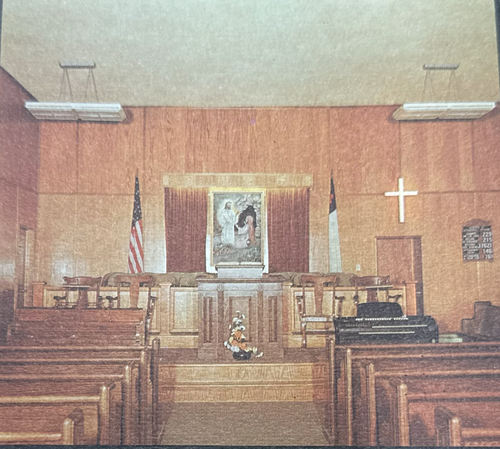
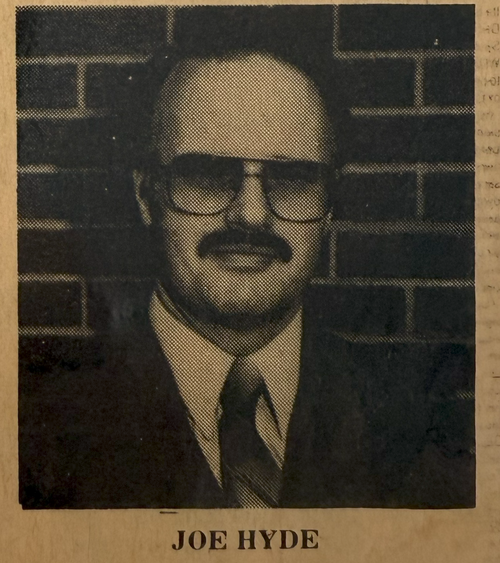
(Left) 1985 photo of Rev. Joe Hyde from the hiring announcement published in the Piqua Daily Call.
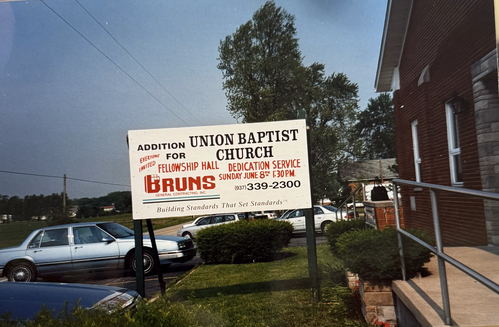
(Above) A sign advertising the dedication service for the new fellowship hall.
(Below) Rev. David Mix pictured with a commemorative plaque gifted to the church by Bruns Construction, who completed the building project.
(Below) Rev. David Mix pictured with a commemorative plaque gifted to the church by Bruns Construction, who completed the building project.
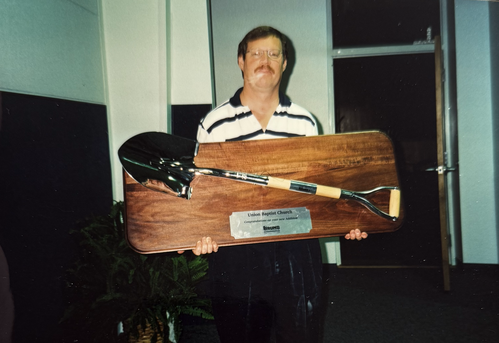
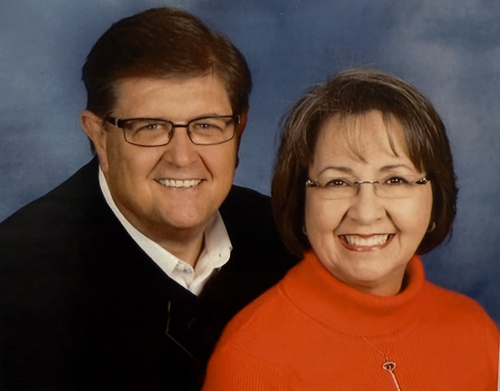
(Above) 2007 church directory photo of Pastor Dale Adkins and his wife Debbie
ministry in the 21st century
In the final years of Rev. Joe Hyde's pastorate, a building committee was formed to plan an addition to the church. They decided to add a 50 foot by 80 foot general purpose addition. Once Rev. Hyde left, the responsibility to carry on this vision fell to the new pastor, Rev. David Mix (2000-2005). In 2000, it was decided that the church did not need two properties, so the trustees sold the parsonage on Alexander Drive in Piqua and put the money into a building fund. Much work was then done in remodeling the original parsonage, including the addition of a two car garage. In 2001, it was necessary to obtain a clear deed to the church property, as the bank would not honor the present deed with a clause in it referring to the Riddle heirs. Two living heirs were located and signed waivers, and the probate court then granted a clean deed. This providential blessing cleared the way for the church to move forward.
On May 8, 2002, the church voted to proceed with building the general purpose addition. Ground breaking was scheduled for May 30, 2002, and Bruns Construction was contracted to do the work. The addition was completed on June 8, 2003. The total cost of the new fellowship hall was $290,000. A loan of $160,000 was obtained by the church in 2002 and it was completely paid off by 2010. Union is blessed to have this venue for weddings, annual Homecoming dinners, and other church or community events.
When Rev. Mix resigned at the end of 2005, Pastor Dale Adkins (2006-2018) took his place. Pastor Dale reinvigorated a lot of the ministries at Union by doing outreach to Piqua Manor and other assisted living facilities, starting an Awana program for the youth, and implementing a child abuse prevention policy for the children's ministry. He put a strong emphasis on a “Family First” philosophy of ministry and community outreach. It was under his guidance that the church voted to disassociate from the American Baptist Churches of Ohio and American Baptist Churches USA national association on January 17, 2016.
When Pastor Dale resigned as pastor in 2018, Union entered into a difficult six year period. The church received faithful pulpit supply preaching from Dale Stover, Noah Walkup, David Mason, and others, but the lack of a lead pastor left many ministries in limbo. Church members were unsure about how to move forward. Then the Covid-19 pandemic in 2020-2021 forced in-person services to shut down completely. Church members still participated in devotions over Facebook, but the church's momentum was halted. And after a short stint from Stephen Jones as pastor (2021-2023), the church was left to pick up the remaining pieces of their ministries and forge something new.
In his providence, God brought Bill Berkheiser to serve as interim pastor. Bill served as Senior Pastor at First Christian Church of Kirkwood, NY for 20 years, and his family moved to Ohio so that his wife Shannon could start a new role at Cedarville University. Pastor Bill shepherded the church through the loss of Oran Thomas, who returned to Union as a church member in 2008 and remained here until his death in 2024. He also guided the church through grieving the sudden loss of Mike Teeters, a longstanding lay leader in the church who served as a deacon and in many other roles. Pastor Bill encouraged the church to refocus on the basics: displaying the truths of the gospel in every area of life, supporting missions efforts, and healing from pain and loss. The church began preparing for new growth by fully renovating the old church basement and transforming it into a children's ministry hub.
On May 8, 2002, the church voted to proceed with building the general purpose addition. Ground breaking was scheduled for May 30, 2002, and Bruns Construction was contracted to do the work. The addition was completed on June 8, 2003. The total cost of the new fellowship hall was $290,000. A loan of $160,000 was obtained by the church in 2002 and it was completely paid off by 2010. Union is blessed to have this venue for weddings, annual Homecoming dinners, and other church or community events.
When Rev. Mix resigned at the end of 2005, Pastor Dale Adkins (2006-2018) took his place. Pastor Dale reinvigorated a lot of the ministries at Union by doing outreach to Piqua Manor and other assisted living facilities, starting an Awana program for the youth, and implementing a child abuse prevention policy for the children's ministry. He put a strong emphasis on a “Family First” philosophy of ministry and community outreach. It was under his guidance that the church voted to disassociate from the American Baptist Churches of Ohio and American Baptist Churches USA national association on January 17, 2016.
When Pastor Dale resigned as pastor in 2018, Union entered into a difficult six year period. The church received faithful pulpit supply preaching from Dale Stover, Noah Walkup, David Mason, and others, but the lack of a lead pastor left many ministries in limbo. Church members were unsure about how to move forward. Then the Covid-19 pandemic in 2020-2021 forced in-person services to shut down completely. Church members still participated in devotions over Facebook, but the church's momentum was halted. And after a short stint from Stephen Jones as pastor (2021-2023), the church was left to pick up the remaining pieces of their ministries and forge something new.
In his providence, God brought Bill Berkheiser to serve as interim pastor. Bill served as Senior Pastor at First Christian Church of Kirkwood, NY for 20 years, and his family moved to Ohio so that his wife Shannon could start a new role at Cedarville University. Pastor Bill shepherded the church through the loss of Oran Thomas, who returned to Union as a church member in 2008 and remained here until his death in 2024. He also guided the church through grieving the sudden loss of Mike Teeters, a longstanding lay leader in the church who served as a deacon and in many other roles. Pastor Bill encouraged the church to refocus on the basics: displaying the truths of the gospel in every area of life, supporting missions efforts, and healing from pain and loss. The church began preparing for new growth by fully renovating the old church basement and transforming it into a children's ministry hub.
A New Chapter
On the approval of Bill Berkheiser and the pastor search committee, Union voted in Nathan Justice as the new pastor in November 2024, and he began his duties in January 2025. His goal is to set a foundation for the future by building on the congregation's strengths and updating old systems. This website and the availability of online giving are just a few of the exciting changes that have already begun under his leadership. Pastor Nathan looks forward to seeing how God will use this historic, rural church to accomplish his kingdom purposes.
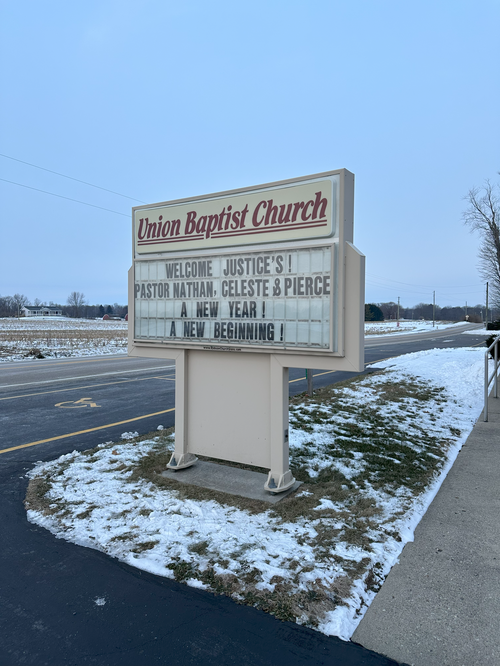
Be a part of our story
Join us every Sunday as we gather for Sunday School at 9:15am and come together in worship at 10:30am!
